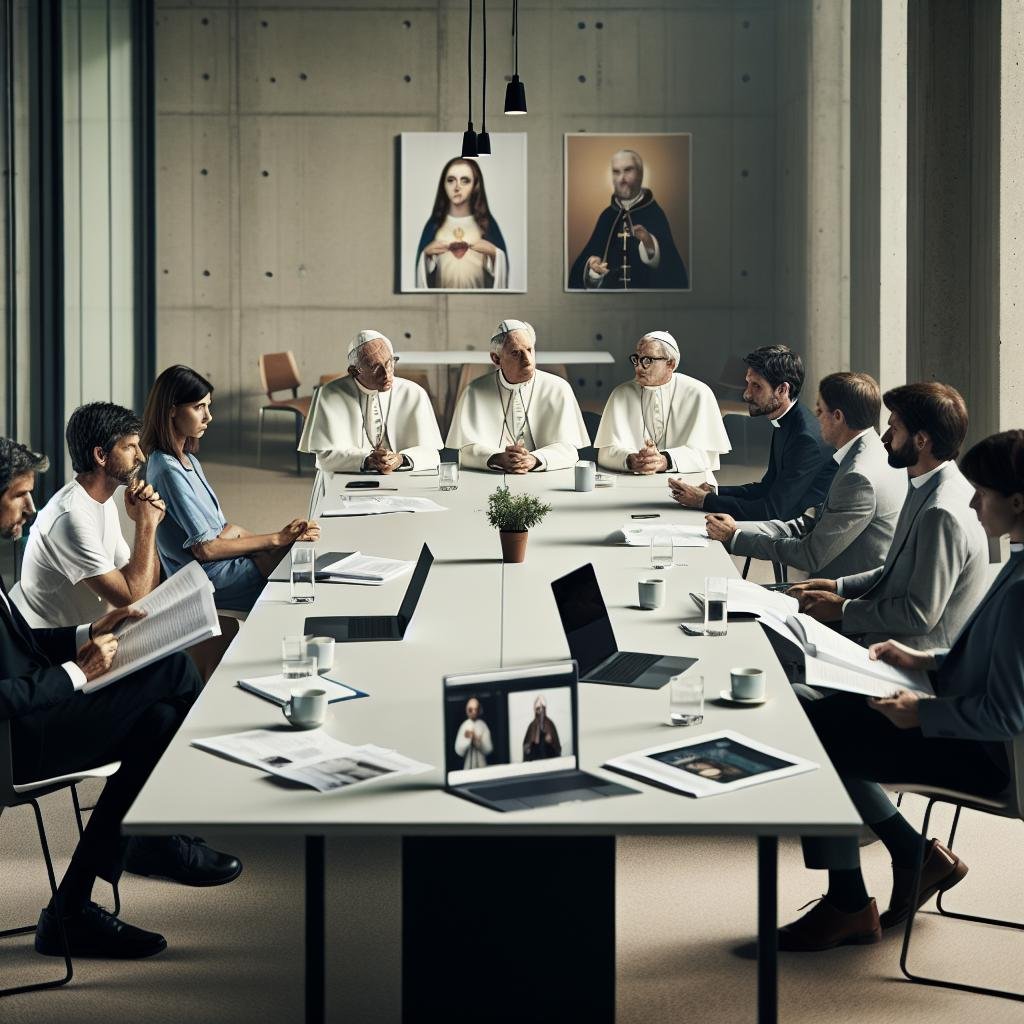
Trump’s AI Image with Pope: Essential Insights into Catholic Approval
Former President Donald Trump dismissed criticisms about his campaign’s use of an AI-generated image depicting him with Pope Francis. Despite backlash from the Vatican, Trump insisted during a Fox News interview that “the Catholics loved it” and downplayed concerns about the image’s authenticity. This incident highlights growing tensions around AI-created content in political campaigns and raises important questions about religious imagery in political messaging.
The Controversial AI Image and Vatican Response
In late April 2024, the Trump campaign shared an AI-generated image on Truth Social showing Trump and Pope Francis together. The image quickly drew attention for its clearly artificial nature, with the Pope wearing what appeared to be a Trump-style puffy jacket. Vatican officials responded with unusual speed, calling the use of the Pope’s image “manipulative” and emphasizing that the Holy See does not endorse political candidates.
The Vatican statement specifically noted: “Any instrumentalization of the person of the Holy Father is not appropriate.” This rare direct comment from Vatican officials underscores their concern about the political use of the Pope’s likeness, especially in artificially created media.
Trump’s Reaction to the Controversy
When questioned about the image during a Fox News town hall on May 5, Trump brushed off concerns about its AI origin. “I thought it was fine,” he remarked, adding that “the Catholics loved it.” The former president seemed unfazed by both the Vatican’s criticism and questions about using artificial intelligence to create politically advantageous imagery.
Trump further suggested that the Pope “would have loved” the image as well, despite the clear statement from Vatican officials indicating otherwise. This disconnect highlights the complex intersection of politics, religion, and emerging technology that campaigns now navigate.
AI in Political Campaigns: A Growing Trend
The Trump-Pope image controversy is not an isolated incident but part of a broader pattern of AI-generated content appearing in the 2024 presidential race. Both major political parties have begun incorporating artificial intelligence into their campaign strategies, raising concerns about voter confusion and misinformation.
Political strategists point to several key developments in this area:
- The Biden campaign has faced similar criticism for AI-enhanced images
- Political action committees increasingly use AI to create compelling visual content
- Regulatory frameworks struggle to keep pace with rapidly evolving AI capabilities
- Voters report growing difficulty distinguishing between real and AI-generated content
According to a Pew Research Center study, approximately 60% of Americans express concern about AI-generated content influencing elections. This widespread unease suggests that campaigns may need to develop clearer policies about their use of artificial intelligence.
The Catholic Vote and Political Imagery
Trump’s assertion that “the Catholics loved it” points to the strategic importance of Catholic voters in American elections. The Catholic voting bloc, which comprises roughly 22% of the U.S. population, has historically functioned as a swing demographic. Recent elections show Catholics nearly evenly split between Democratic and Republican candidates.
Political analysts note several factors that make the Trump-Pope image particularly notable:
- Catholics in key battleground states like Pennsylvania and Michigan could determine electoral outcomes
- Religious imagery carries significant emotional weight with faith communities
- Pope Francis specifically has maintained higher approval ratings among U.S. Catholics than his predecessors
- The implied endorsement of a religious leader can influence voter perception
Dr. Maria Gonzalez, professor of political communication at Georgetown University, explains: “When campaigns use religious imagery, they’re attempting to transfer the moral authority of faith leaders to political candidates. The challenge comes when those religious figures push back against such associations.”
Real-World Example
This isn’t the first time political campaigns have courted controversy with religious imagery. In 2020, then-President Trump posed with a Bible outside St. John’s Church near the White House after law enforcement cleared protesters from the area. That photo opportunity drew criticism from religious leaders, including the Episcopal bishop of Washington, who called it “an abuse of sacred symbols.”
The difference now, of course, is that AI allows campaigns to create images that never actually happened. As one Catholic voter from Michigan put it: “I saw that picture and initially thought, ‘Wow, the Pope met with Trump?’ Then I realized it wasn’t real. That momentary confusion is exactly the problem.”
Ethical Questions About AI in Political Messaging
The Trump-Pope image raises important ethical questions about the use of artificial intelligence in political campaigns. While technology has always influenced political communication—from the first televised debates to social media—AI represents a qualitative shift in how content can be created and manipulated.
Key ethical considerations include:
- Transparency requirements for AI-generated content
- The rights of public figures whose likenesses are used without permission
- Voter ability to distinguish between real and synthetic media
- The role of platforms in labeling or restricting misleading content
The Federal Election Commission has begun exploring guidelines for AI in political advertising, though comprehensive regulations remain elusive. Meanwhile, social media platforms have implemented various labeling systems for AI content with mixed results.
“We’re in uncharted territory,” notes digital ethics expert James Wilson. “Campaigns are naturally going to push boundaries with new technology, but voters deserve to know when they’re seeing something that never actually happened.”
The Vatican’s Unusual Direct Response
Vatican observers note that the Holy See’s quick and direct response to the AI image represents a departure from typical practice. The Vatican rarely comments on specific campaign materials, preferring instead to address broader ethical and moral issues in politics.
This deviation suggests serious concern about the potential impact of AI-generated content that implies papal endorsement. Pope Francis has previously emphasized the importance of truth in communications and warned about the dangers of manipulative media.
In a 2018 message for World Communications Day, the Pope specifically warned against “snake-tactics” in media, stating that “the truth will set you free.” This philosophical approach appears increasingly relevant in an era of synthetic media and political manipulation.
Public Perception and Media Literacy
Public reaction to the Trump-Pope image controversy highlights varying levels of media literacy among voters. While some immediately recognized the image as artificial, others initially believed it represented a real meeting between the two figures.
This gap in perception skills presents challenges for democratic discourse, particularly as AI-generated content becomes more sophisticated and difficult to identify. Education experts point to several approaches that might help:
- Enhanced media literacy education in schools
- Clear labeling requirements for AI-generated political content
- Development of better AI detection tools for consumers
- Greater transparency from campaigns about their use of artificial intelligence
“The technology is advancing faster than our collective ability to process it critically,” explains Dr. Samantha Lee, director of the Center for Digital Citizenship. “When a former president can casually dismiss concerns about synthetic media, it suggests we haven’t established strong enough norms around its use.”
Looking Forward: Campaign Rules in the AI Era
As the 2024 presidential campaign continues, both major parties face decisions about how they’ll use—and potentially restrict—AI-generated content. Campaign strategists must balance the compelling creative possibilities of AI against growing public wariness about manipulated media.
Several developments could shape the future landscape:
- Voluntary campaign pledges regarding AI transparency
- Platform-specific rules about synthetic political content
- Potential legislative action at state or federal levels
- Evolving public expectations about authenticity in political messaging
The Trump-Pope image controversy may ultimately serve as a useful case study for establishing clearer boundaries. As one campaign consultant anonymously told Politico, “Everyone’s testing the limits right now, but eventually we’ll settle on some standards. The question is whether those come from campaigns, platforms, or regulators.”
The Intersection of Faith, Politics, and Technology
At its core, the controversy highlights the complex intersection of faith communities, political campaigns, and emerging technologies. Religious voters increasingly find themselves navigating political messages that leverage faith symbols and leaders through artificial means.
For Catholic voters specifically, the AI image presents a particular challenge. While some may appreciate the implied connection between Trump and the Pope, others might view the synthetic portrayal as manipulative or disrespectful to their spiritual leader.
Father Robert Barron, a Catholic priest and media commentator, observed: “There’s something fundamentally problematic about creating false imagery involving religious leaders. It instrumentalizes faith for political gain and potentially misleads believers about where their spiritual guides stand.”
Conclusion: Beyond the Single Image
While Trump’s dismissal of concerns about the AI-generated image with Pope Francis might seem like a minor campaign moment, it represents larger questions facing voters, campaigns, and society. As artificial intelligence becomes more integrated into political messaging, the boundaries between reality and creative license grow increasingly blurred.
The controversy serves as a reminder that technological capabilities often outpace ethical frameworks. For voters approaching the 2024 election, developing critical media consumption skills becomes ever more essential—not just for evaluating candidates’ positions, but for determining what’s real in the first place.
In this new landscape, both campaigns and voters face a shared challenge: how to harness the creative potential of new technologies while maintaining the foundations of truthful democratic discourse.
Have thoughts about AI-generated content in political campaigns? Share your perspective in the comments below, or explore more articles about technology’s role in the 2024 election.


